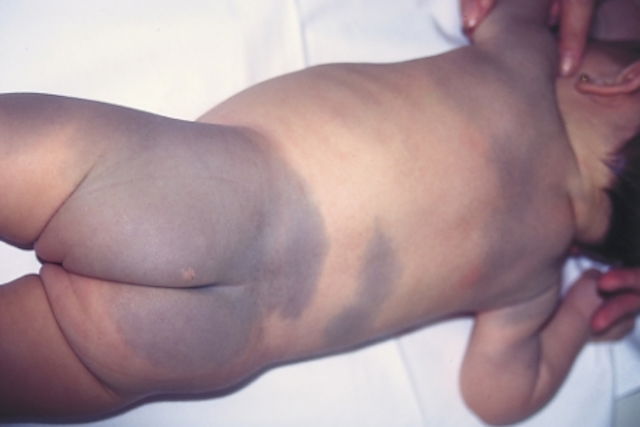A Mongolian spot is a congenital spot on the skin that appears in newborns. It typically has a blue, gray or slightly green color is most commonly noted in the lower back or buttocks.
A mongolian spot, also known as congenital dermal melanocytosis or slate gray nevi, is more common in Asian babies. It is caused by the accumulation of melanocytes in the innermost layer of the skin. These cells are responsible for the production of melanin, which is the pigment that gives the skin color.
Generally, Mongolian spots are not a sign of any health problem or trauma during birth. They are diagnosed by the pediatrician shortly after birth and generally disappear within the first year of the baby's life, without the need for any treatment.

Common symptoms
The main symptoms of Mongolian spots are:
- A single spot or multiple spots that are blue, dark gray or slightly green in color
- Flat spots, with normal skin texture
- Round, oval, or irregular-edged spots, usually measuring about 2 to 10 centimeters in diameter.
A Mongolian spot is most commonly noted on the buttocks or lower back, but it can also appear on the shoulders, arms, legs, groin or chest.
Confirming a diagnosis
A Mongolian spot diagnosis is typically confirmed by a pediatrician as soon as the baby is born, following a detailed physical examination of the baby's skin. Diagnosis usually does not require any specific, targeted tests.
When assessing the spot, its characteristics and its location, the doctor can also rule out other health problems, such as a nevus of Ota, in which the spots usually appear on the face or around the eyes. A Mongolian spot can also present similarly to a nevus of Ito, which is characterized by spots on the neck or upper back.
If the spot appears after the first weeks of the baby's life or is present in other regions of the body, the doctor may ask the parents or caregivers when the spot appeared. The doctor will also assess the spot's appearance, color and characteristics, in order to identify the type of spot and rule out other conditions that could lead to its appearance, such as a hematoma, which can arise due to deliberate trauma or child abuse.
Possible causes
Mongolian spots are caused by a congenital skin disorder that appears during embryonic development.
In the first 10 weeks of pregnancy, melanocytes. These are the cells that produce melanin, the pigment that gives color to the skin, and are found in the innermost layer of the skin, called the dermis. Normally, between weeks 11 and 14 of pregnancy, these melanocytes migrate to the outer layers of the skin (epidermis).
When these melanocytes do not migrate to the epidermis until a maximum of 20 weeks of gestation, they accumulate in the dermis, actively producing melanin, and forming the Mongolian spot.
Treatment options
Mongolian spots generally disappear within the first year of life, without any treatment. They rarely persist after 6 years of age.
These spots gradually fade and become increasingly lighter as the baby grows. Some areas may lighten more quickly than others, but once they are lighter, they will not turn dark again.
However, in some cases, the spots can persist into adulthood and can affect other areas of the body such as the face, arms, hands and feet. In these cases, treatment should be guided by a dermatologist who may recommend laster therapies.
How to take care of baby's skin
Because the skin with Mongolian spots is darker than the other skin, there is naturally increased sun protection in these areas Nonetheless, it is still important to protect the baby's skin from the sun. Babies over 6 months can use appropriate sunscreen, while younger babies should be protected from prolonged, direct exposure.
Despite this, all babies should get some sun for vitamin D production, as this is important for bone development and strengthening.. Aim for about 15 to 20 minutes of sun per day, early in the morning or at the end of the day, when UV rays are weaker.
Babies should be accompanied by an adult and be appropriately clothed to avoid overheating. Ideally, the baby's face, arms and legs should be exposed to the sun. If you think your baby is hot or cold, check their temperature by placing your hand on the baby's neck and back.
Can Mongolian spots turn into cancer?
Mongolian spots do not pose any skin problems and are not associate with cancer.






























